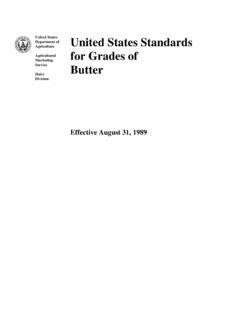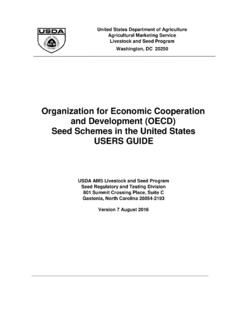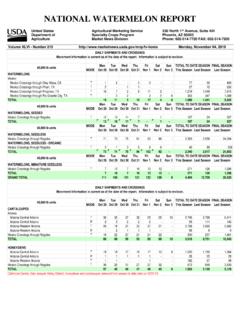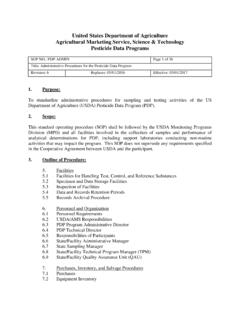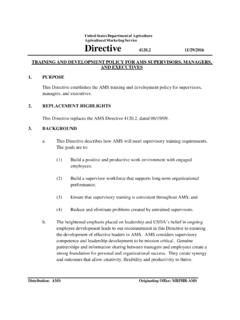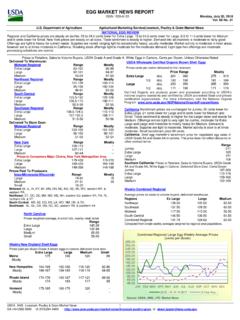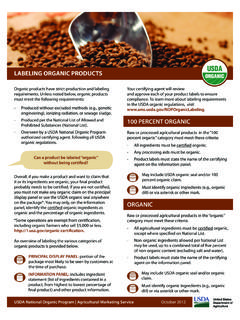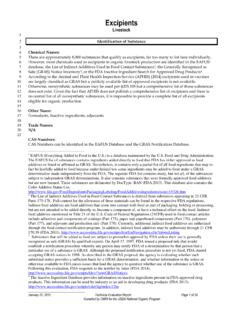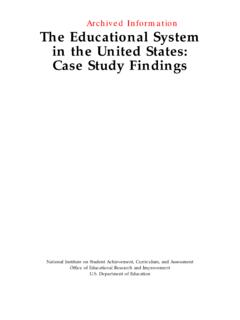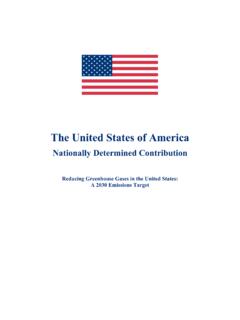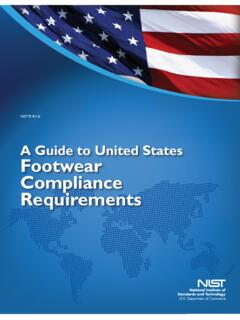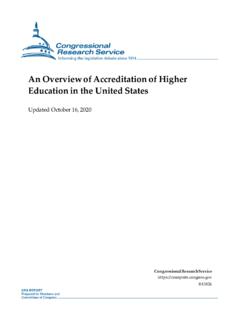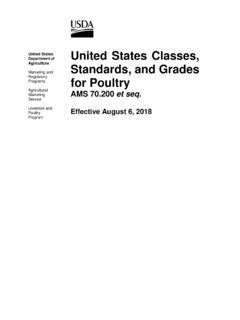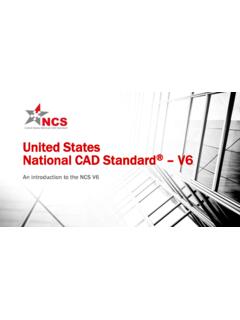Transcription of United States Department of United States Standards, …
1 United States Department of Agriculture United States standards , Marketing and Regulatory Grades, and weight Programs Agricultural classes for Shell Eggs Marketing Service AMS 56. Poultry Programs Effective July 20, 2000. FOREWORD. These standards , grades, and weight classes have been developed and are promulgated pursuant to the authorities contained in the Agricultural Marketing Act of 1946, as amended (7. 1621 et seq.). The voluntary USDA shell egg grading program operates under these standards , grades, and weight classes as well as the shell egg grading regulations. The voluntary program provides for interested parties a national grading service based on official standards , grades, and weight classes for shell eggs. The costs involved in furnishing this grading program are paid by the user of the service.
2 The grading program, regulations, standards , grades, and weight classes establish a basis for quality and price relationship and enable more orderly marketing. Consumers can purchase officially graded product with the confidence of receiving quality in accordance with the official identification. The Regulations Governing the Voluntary Grading of Shell Eggs are printed in the Code of Federal Regulations (CFR) as 7 CFR Part 56. The regulations are also available on the Internet at The United States standards , Grades, and weight classes for Shell Eggs were removed from the CFR on December 4, 1995. They are maintained by the Agricultural Marketing Service, Department of Agriculture, as AMS 56. This document contains the standards , grades, and weight classes that are the most current to date. Past changes are enumerated in the bracketed footnotes following the applicable sections.
3 This document is also available on the Internet at Look under Publications For printed copies of the regulations or the standards , grades and weight classes : Call: (202) 720-2356. Fax: (202) 690-2930. Write: USDA, AMS, Poultry Programs STOP 0259, Room 3944-South 1400 Independence Avenue, SW. Washington, DC 20250-0259. The Department of Agriculture (USDA) prohibits discrimination in all its programs and activities on the basis of race, color, national origin, age, disability, and where applicable, sex, marital status, familial status, parental status, religion, sexual orientation, genetic information, political beliefs, reprisal, or because all or a part of an individual's income is derived from any public assistance program. (Not all prohibited bases apply to all programs.) Persons with disabilities who require alternative means for communication of program information (Braille, large print, audiotape, etc.)
4 Should contact USDA's TARGET Center at (202) 720-2600 (voice and TDD). To file a complaint of discrimination write to USDA, Director, Office of Civil Rights, 1400 Independence Avenue, , Washington, 20250-9410 or call (800) 795-3272 (voice) or (202) 720-6382 (TDD). USDA is an equal opportunity provider and employer AMS-56. United States standards , Grades, and weight classes for Shell Eggs Section Page United States standards for Quality of Individual Shell Eggs Application .. 2. AA Quality .. 2. A Quality .. 2. B Quality .. 2. 3. Check .. 3. Terms descriptive of the shell .. 3. Terms descriptive of the air cell .. 3. Terms descriptive of the white .. 4. Terms descriptive of the yolk .. 5. General terms .. 5. United States Grades and weight classes for Shell Eggs General .. 6. United States Consumer Grades and weight classes for Shell Eggs Grades.
5 6. Summary of grades .. 8. weight classes .. 9. United States Nest-Run grade and weight classes for Shell Eggs grade .. 9. Summary of grade .. 10. weight classes .. 11. Authority: 7 1621-1627. Summary of standards for Quality of Individual Shell Eggs Shell Eggs .. 12. United States standards , Grades, and weight classes for Shell Eggs 1. AMS 56 - July 20, 2000. United States standards for Quality of Individual Shell Eggs Application. (a) The United States standards for quality of individual shell eggs contained in this subpart are applicable only to eggs that are the product of the domesticated chicken hen and are in the shell. (b) Interior egg quality specifications for these standards are based on the apparent condition of the interior contents of the egg as it is twirled before the candling light.
6 Any type or make of candling light may be used that will enable the particular grader to make consistently accurate determination of the interior quality of shell eggs. It is desirable to break out an occasional egg and by determining the Haugh unit value of the broken-out egg, compare the broken-out and candled appearance, thereby aiding in correlating candled and broken-out appearance. [28 FR 6346, June 20, 1963. Redesignated at 42 FR 32514, June 27, 1977, and amended at 46 FR 39571, Aug. 4, 1981. Redesignated at 46 FR 63203, Dec. 31, 1981]. AA Quality. The shell must be clean, unbroken, and practically normal. The air cell must not exceed 1/8 inch in depth, may show unlimited movement, and may be free or bubbly. The white must be clear and firm so that the yolk is only slightly defined when the egg is twirled before the candling light.
7 The yolk must be practically free from apparent defects. [38 FR 26798, Sept. 26, 1973. Redesignated at 42 FR 32514, June 27, 1977, and at 46 FR 63203, Dec. 31, 1981]. A Quality. The shell must be clean, unbroken, and practically normal. The air cell must not exceed 3/16 inch in depth, may show unlimited movement, and may be free or bubbly. The white must be clear and at least reasonably firm so that the yolk outline is only fairly well defined when the egg is twirled before the candling light. The yolk must be practically free from apparent defects. [38 FR 26798, Sept. 26, 1973. Redesignated at 42 FR 32514, June 27, 1977, and at 46 FR 63203, Dec. 31, 1981]. B Quality. The shell must be unbroken, may be abnormal, and may have slightly stained areas. Moderately stained areas are permitted if they do not cover more than 1/32 of the shell surface if localized, or 1/16 of the shell surface if scattered.
8 Eggs having shells with prominent stains or adhering dirt are not permitted. The air cell may be over 3/16 inch in depth, may show unlimited movement, and may be free or bubbly. The white may be weak and watery so that the yolk outline is plainly visible when the egg is twirled before the candling light. The yolk may appear 2 United States standards , Grades, and weight classes for Shell Eggs AMS 56 - July 20, 2000. dark, enlarged, and flattened, and may show clearly visible germ development but no blood due to such development. It may show other serious defects that do not render the egg inedible. Small blood spots or meat spots (aggregating not more than 1/8 inch in diameter) may be present. [46 FR 39571, Aug. 4, 1981; 46 FR 42441, Aug. 21, 1981. Redesignated at 46 FR 63203, Dec. 31, 1981]. Dirty.
9 An individual egg that has an unbroken shell with adhering dirt or foreign material, prominent stains, or moderate stains covering more than 1/32 of the shell surface if localized, or 1/16 of the shell surface if scattered. [46 FR 39571, Aug. 4, 1981. Redesignated at 46 FR 63203, Dec. 31, 1981]. Check. An individual egg that has a broken shell or crack in the shell but with its shell membranes intact and its contents do not leak. A "check" is considered to be lower in quality than a "dirty.". [32 FR 8232, June 8, 1967. Redesignated at 42 FR 32514, June 27, 1977, and at 46 FR 63203, Dec. 31, 1981]. Terms descriptive of the shell. (a) Clean. A shell that is free from foreign material and from stains or discolorations that are readily visible. An egg may be considered clean if it has only very small specks, stains, or cage marks, if such specks, stains, or cage marks are not of sufficient number or intensity to detract from the generally clean appearance of the egg.
10 Eggs that show traces of processing oil on the shell are considered clean unless otherwise soiled. (b) Dirty. A shell that is unbroken and that has dirt or foreign material adhering to its surface, which has prominent stains, or moderate stains covering more than 1/32 of the shell surface if localized, or 1/16 of the shell surface if scattered. (c) Practically normal (AA or A quality). A shell that approximates the usual shape and that is sound and is free from thin spots. Ridges and rough areas that do not materially affect the shape and strength of the shell are permitted. (d) Abnormal (B quality). A shell that may be somewhat unusual or decidedly misshapen or faulty in soundness or strength or that may show pronounced ridges or thin spots. [46 FR 39571, Aug. 4, 1981. Redesignated at 46 FR 63203, Dec.]
